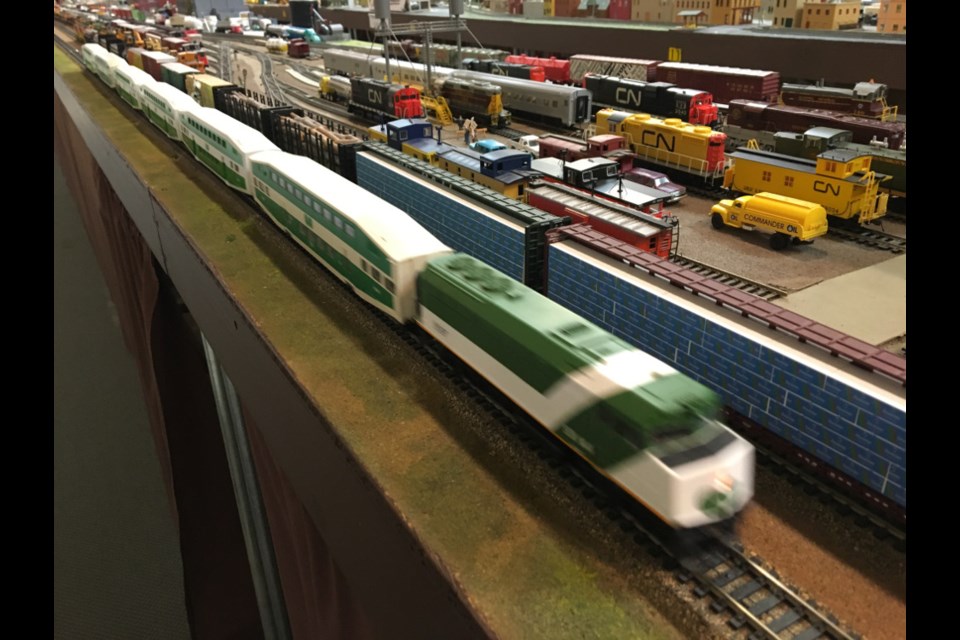In a world of social media and video games (not that there’s anything wrong with that), a large model railroad and its surrounding miniature city, representing an older and less complicated world, continues to fascinate visitors at the Sault Ste. Marie Model Railroad Club, situated at Wellington Square Mall.
While the folks at the Canadian Bushplane Heritage Centre are to be commended for preserving our area’s aviation history in a real, life-sized way, Wayne Brittain, Sault Ste. Marie Model Railroad Club president, and his fellow club members, are to be commended for preserving the Sault’s railroad past, at least in a miniature way, pouring their hearts into the model railroad and the surrounding miniature city they’ve built around it.
“I’ve been around trains since I was five years old,” Wayne grinned, speaking to SooToday.
“My uncle was a train driver, my father was too, and so was I,” Wayne said.
That was back in the day when train drivers were called engineers, (now known as industrial locomotive operators).
A former ACR engineer, Wayne recalled “Algoma Steel had 300 miles of track within the steel plant if you put them all together. Not now.”
Despite being miniature in size, the Sault Ste. Marie Model Railroad Club’s train cars are highly detailed and don’t come cheap.
“The ultimate Cadillac of train cars will cost you about 35 bucks, the Cadillac of engines will cost up to 350 bucks,” Wayne said.
The club now has “about half a dozen” members left, Wayne said, down from the original 10.
“It’s important to me because it’s a hobby, like model car racing, but I do it for kids too. Kids love it, and people in their 90s too. Kids that come in, if they’re too small to see the display, we’ll lift them up into shopping carts we have and wheel them around to see it.”
“It keeps me sane,” Wayne smiled.
Wayne said he would recommend taking model railroading up as a hobby, but cautioned “it’s a ‘tinker tinker’ hobby. We just got finished fixing some electrical problems and it took us an hour and a half. You’ve got to take things apart to fix them.”
Apart from the main display, a second model railroad is set up in the railroad club’s front window, which is replaced by a holiday-themed train set during the Christmas season.
The main display is 50 feet long by nine feet wide, the longest train set consisting of 37 cars, other smaller sets consisting of about a dozen cars, Wayne said.
The trains are surrounded by landscaped nature scenes including hills, valleys, rivers and streams, depicting tiny figures doing everything from hunting and fishing to getting married outside a miniature church.
There are areas of the display which show a beehive of railyard, construction and industrial activity, which takes one’s mind back to to the day when our city and area was expanding.
The display, in a nod to modern green energy, includes miniature wind turbines.
There is also a miniature Tim Hortons coffee shop and Dairy Queen included.
The train is run by conventional, electrical push button technology, but newer sets can be run by wireless technology.
The club has an extensive collection of ‘how to’ books in a library located at the rear of the railroad space.
A catalogue published in Milwaukee, Wisconsin, on the shelf at the club’s space, has an array of model railroad pieces which can now be purchased online.
No online activity for Wayne though.
“I just write them a letter and send them a cheque,” he laughed.
He first helped build the model railroad by purchasing pieces of it through his travels all across North America.
There are seemingly countless little treasures to be seen in the display (and which visitors are encouraged to spot), and they include;
- a woman hanging laundry
- two joggers
- Boy Scouts with a tent
- a moose
- a dog (at a fire hydrant!)
- a motorist being issued a speeding ticket
- a non-fatal motor vehicle collision at a city street corner
- three phone booths
- a hot dog vendor
- hobos with a camp fire
Wayne, by the way, emphasized children should never play on or near real-life railroad tracks, as death or serious injury could result.
The club started up in 1962, members meeting in each other’s homes.
Member Peter Christie, then manager of Sears, arranged to have the club set up the model railroad’s layout on the second storey of the old Sears building (now home to Fabricland Home Decor Centre at 387 Queen Street East).
Sears moved to Station Mall in 1973, and the club moved from the Queen Street building when its owner sold it to Fabricland in 1989.
The club’s members dismantled the railroad’s components, loaded it on a transport, reassembled and displayed it at the Canadian National Exhibition (CNE) in 1990 for three weeks (‘transportation’ being the theme of the CNE that year).
Upon returning to the Sault, Wayne said, the club brought the railroad to Wellington Square Mall as a space to repair it, but the mall’s management agreed to let the club and its display stay on a permanent basis, first near the Rad Zone, and now near the mall’s west entrance.
That space, Wayne said, is big enough to accommodate the railroad, which consists of 20 joined pieces, and which took about two years to build.
“I don’t know how much it cost to build, I never added it up,” Wayne said.
Wayne, 83, a Kirkland Lake native, moved to the Sault in 1951 and worked for the Algoma Central Railway (ACR), then began working at Algoma Steel in 1965, retiring in 1991.
“I’d go back to work on the railroad tomorrow,” Wayne said.
